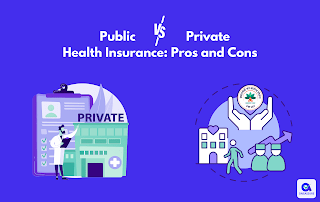 |
| Private vs Public Health Insurance: Which Is Right for You? |
Private vs Public Health Insurance: Which Is Right for You?
Choosing the right health insurance plan is one of the most important decisions you can make in 2025, especially with rising medical costs and evolving healthcare systems in countries like the US, Canada, and Australia. One of the fundamental choices is deciding between private and public health insurance. Each option comes with its advantages, disadvantages, and varying levels of coverage and flexibility. This article helps you understand how both systems work and which one might suit your lifestyle and needs.
Understanding Public Health Insurance
Public health insurance is funded and operated by government programs. In countries like Canada and Australia, this type of insurance provides coverage for a wide range of medical services. The goal is to offer healthcare access to all citizens, regardless of income.
- Pros: Low or no cost to the insured, universal coverage, no exclusions based on pre-existing conditions.
- Cons: Long wait times for non-emergency treatments, limited provider options, fewer elective services covered.
Understanding Private Health Insurance
Private health insurance is provided by independent companies. It typically offers more comprehensive and flexible coverage, including private hospital rooms, specialist access, and elective procedures. In the US, private insurance is the dominant model.
- Pros: Shorter wait times, wider choice of doctors and hospitals, custom plan options.
- Cons: Higher premiums, deductibles, and out-of-pocket costs.
Cost Comparison in 2025
Cost is a major factor when choosing health insurance. Public systems are subsidized through taxes, while private plans charge monthly premiums. In 2025, average monthly private insurance premiums are:
- USA: $500 - $800
- Canada: $100 - $300 (supplemental private coverage)
- Australia: $150 - $400
These costs vary based on age, location, and plan type.
Coverage and Services
Public insurance usually covers basic health needs like GP visits, emergency care, and hospitalization. Private plans, however, often cover:
- Dental and vision care
- Physical therapy
- Alternative treatments (e.g., acupuncture)
- Private hospital accommodation
Which One Is Right for You?
The right choice depends on your health needs, financial situation, and location. If you have chronic conditions or want fast access to specialists, private insurance might be better. If you’re generally healthy and want to save money, public coverage may suffice.
Combining Both: The Hybrid Approach
Many people combine both systems. For example, Australians often use Medicare (public) for basic needs and private insurance for added benefits. This strategy offers the best of both worlds: affordability and comprehensive care.
Expert Tips for Choosing Wisely
- Compare plans using online tools
- Read the fine print for exclusions
- Consider your future health needs
- Review provider networks
Conclusion
In 2025, understanding the pros and cons of private vs public health insurance is essential for making an informed decision. Each has unique benefits, and your choice should reflect your healthcare priorities. Whether you choose one or a hybrid approach, staying informed and regularly reviewing your policy will ensure you get the best care at the best value.

This comparison was helpful in breaking down both affordability and access. Choosing the right health insurance really depends on personal needs and long-term priorities.
ReplyDelete